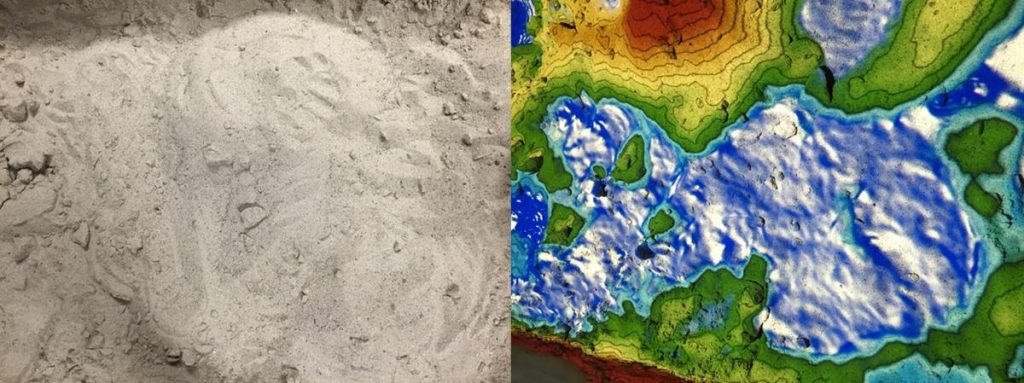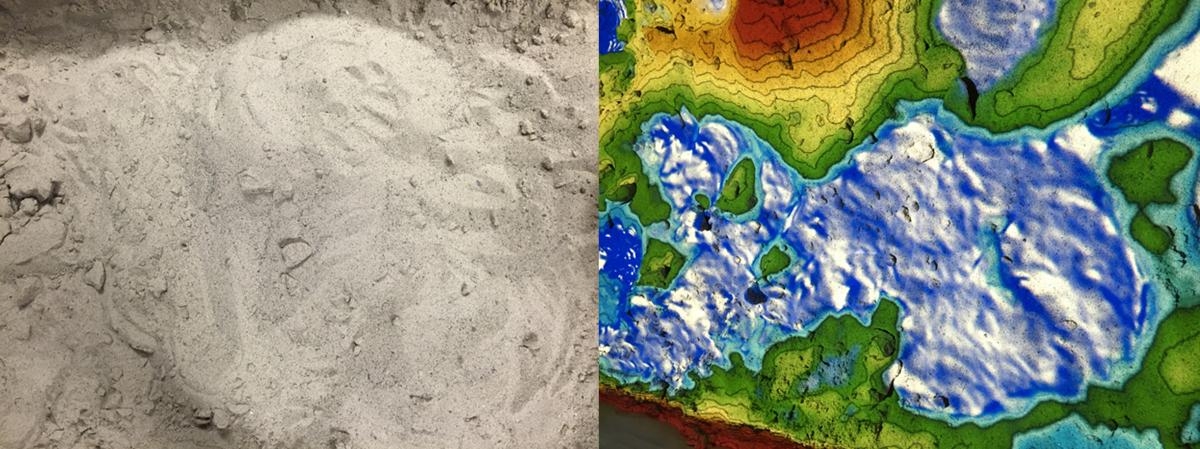
Augmented reality sandbox enhances student learning in Earth and Space Science class
Posted on April 14, 2016
Students of Penn High School’s Earth and Space Science class can put their hands in a sandbox and push the sand around to form various shapes.
But when Earth and Space Science class instructor Mark Watts turns on an augmented reality projector, colorful moraines, drumlins and kettle lakes spring to life. Snow appears on top of mountains formed out of the sand, and ripples wash across blue lakes.
Watts constructed an augmented reality sandbox that has students engaged in learning. Instead of struggling to visualize 3-D shapes from a flat map, the students are creating the 3-D shapes.
“It would be a lot harder to learn with just a 2-D map and a book, and it wouldn’t be as much fun,” Penn High School student Mitchell Spangler said. “On a map, it’s just flat. It’s a lot hard to visualize how it looks. With the augmented reality sandbox, it shows the topographic lines, but when we mold it, it shows how the different lines correspond with the different heights and the spacings.”
Watts’ wife, Penn World Languages Academy leader Kelley Watts, gets the assist for the engaging learning device.
“My wife found the information about the augmented reality sandbox on a Facebook page,” Watts said. “I contacted an instructor at the University of California-Davis, and he had a tutorial on how to set it up, and how to use the ‘Kinect’ camera from a PlayStation 3 for the video input, and then a regular projector for a computer. About the only thing it needs that is really special is a high-quality graphics card, because it actually simulates water and ripples and waves.”
In the augmented reality sandbox, colors contour to the elevation. The computer sees the sand in 3-D, and then a color-coded image is projected onto the top of the sand. As the sand shapes change, so does the color-coded map. Blue represents low areas, red represents high areas. White represents the highest elevations (snow on a mountain).
Students can demonstrate their learning from a two-dimensional map by showing it with the shapes they form in the sandbox.
“For common people, this would be an example of trying on clothes and seeing how they would be on your body type, your height, your width, your size and your weight, but you wouldn’t have to go on through all the hassle of trying on different types of clothes,” Watts said.
Watts put in about 40 hours constructing the device. It involved learning computer software and constructing a frame.
“That was not a small learning curve, but it wasn’t bad,” Watts said of learning computer code. “I really have to give credit to Oliver Kreylos at UC-Davis, who wrote the tutorial. It pretty much walked me though step-by-step.”
Spangler agreed with Watts that the augmented reality sandbox is a difference-maker in the classroom.
“The virtual reality sandbox gives us a visual on how topography affects different things, like movement of water, or other substances, such as lava,” Spangler said. “Other equipment can switch the settings to where the liquid falling off of the sand has the same viscosity as lava or even snow.
“It’s really helpful. It gives us a chance to use our hands to sculpt the environment and see how the rain might fall off of the slopes, or see how long it takes for snow to be permanent on top of a mountain. It allows us to experiment with the shapes of different features, because volcanoes can’t have a slope of more than 30 degrees, because they’re just sediment. We can find that out by pushing the sand together, and if it goes over a certain angle, then gravity will pull the loose sediments down. Because of that, it can only be at a low angle and still be stable.”
Watts said that he has many former students contact him about their learning experiences in Earth and Space Science class.
“One of the things that the kids who go into the armed services tell me is, ‘I thought we were done with that topographic map stuff, but the first thing we had to learn when we got into the service was how to read a topographical map.’ I grin and chuckle and say, ‘It is a good idea where you and everybody else are.’”
Watts said that the time he put into constructing the augmented reality sandbox has paid big dividends in the classroom.
“The students think it’s the coolest thing – for a good 10 minutes, I have their complete attention,” Watts laughed. “ If you’re trying to get a grade school or grammar school kid in earth and space science or geology, this would be just the thing to have them play around with.”
Last Modified January 12, 2022

